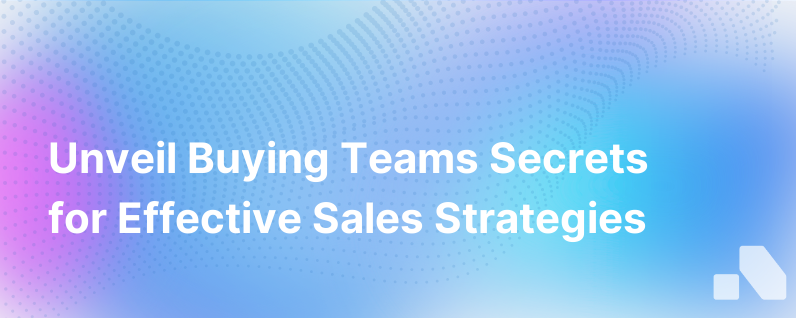
In the intricate world of B2B sales, navigating the landscape of buying teams is often perceived as complex and shrouded in secrecy. For sales professionals, understanding the dynamics within these customer buying groups is akin to uncovering a hidden treasure—crucial for closing deals and fostering long-term partnerships but elusive in its intricacy.
The Enigma of Buying Teams
Buying teams—groups of individuals within a company responsible for evaluating, recommending, and making purchasing decisions—are rarely simple entities. Comprising diverse roles, from key decision-makers and influencers to gatekeepers and end-users, the composition and priorities of these teams can appear labyrinthine to outsiders.
Their processes, influenced by interdepartmental politics, budget constraints, and individual agendas, often seem cloaked in obscurity, making the sales process feel like an exercise in cryptography.
Understanding the intricacies of buying teams is not just helpful but essential. True to the classic axiom, knowledge is power. In B2B sales, an in-depth understanding of your customer's buying team translates into the power to tailor your engagement strategy, develop bespoke value propositions, and cultivate the right relationships.
Demystifying Buying Teams: Unveiling the Veil
The good news is, buying teams don't have to remain an enigma. Today's sales professionals are equipped with an array of tools, techniques, and strategies to decode the composition and behavior of these groups.
- Targeted Research and Intelligence Gathering
The first step toward demystifying buying teams is thorough research. This goes beyond understanding the target company's industry position; it requires a drill-down into individual team members' roles, challenges, and business goals. Sales intelligence platforms can curate relevant data, from social media activity to mutual connections, which can be invaluable when piecing together the buying group puzzle.
- Leveraging Social Selling and Networking
Social selling has made it easier to break through barriers, allowing sales professionals to directly engage with multiple team members across platforms like LinkedIn. By contributing to relevant conversations and showcasing thought leadership, a salesperson can gradually build familiarity and trust, gaining insights into the buying team's dynamics and objectives.
- Developing a Multi-threaded Engagement Strategy
Gone are the days where sales were dependent on a single point of contact. A multi-threaded approach, establishing connections with various buying team members, reduces the risk tied to personnel changes. It also facilitates a deeper understanding of the team's collective and individual objectives, thus fostering a holistic sales strategy.
- Engaging in Active Listening
Sales meetings offer a goldmine of information beyond obvious verbal cues. Active listening and discerning nuances in discussions can reveal the hierarchical structure of the buying team, the influence certain members hold, and implicit decision-making criteria. Turning these insights into actionable intelligence allows the sales process to be fine-tuned to address the buying team's core concerns.
- Facilitating Collaborative Problem-Solving Sessions
Instead of rigid presentations, engaging buying teams in collaborative sessions helps co-create solutions that address their unique challenges. This collaborative approach demystifies the team's objectives by inviting them into the problem-solving process, making their input and concerns evident.
- Seeking Feedback
Feedback from lost deals is as critical as insights from victories. They offer sales professionals a rear-view mirror perspective of where alignment with the buying team was lost or where other competitors may have better understood their needs. Regularly seeking out and acting on feedback is key to decrypting the operational ethos of buying teams.
When these strategies are employed successfully, the once opaque operations of buying teams become transparent, helping to align sales efforts with the customer's true needs and decision-making processes.
The Role of Advanced Sales Intelligence Platforms
In a digital era where data is the new currency, advanced sales intelligence platforms, such as Aomni, offer potent capabilities to penetrate the veil surrounding buying teams. Leveraging artificial intelligence, these platforms provide real-time analytics, insights into company changes, sentiment analysis, and predictive behaviors, translating vast amounts of data into actionable intelligence for sales professionals.
Aomni, for example, acts not just as a data source but as a strategic partner that distills complex, variable information into simplified, strategy-ready formats. The platform facilitates the construction of a highly detailed map of buying teams, guiding sales professionals through the intricate web of relationships, hierarchies, and influences. It enables personalized sales content delivery, making the previously onerous task of understanding each buying team’s dynamics, far more manageable and transparent.
In Conclusion
While buying teams may inherently contain an element of unpredictability and complexity, the veil of secrecy that once exclusively cloaked their operations is gradually lifting. With the right mix of diligent research, strategic engagement, and advanced technological tools like Aomni, sales professionals are well-positioned to gain the insights necessary to effectively engage, convince, and convert B2B buying teams.
In adopting these practices, sales teams can transcend mere transactional interactions, instead cultivating strategic partnerships that respect and respond to the intricate, and no longer secretive, dynamics of the ever-evolving B2B buying team.